Thomas Turnbull
Thomas Turnbull (1824–1907) was a notable New Zealand architect.
Thomas Turnbull | |
|---|---|
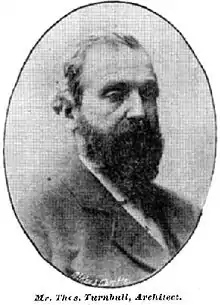 | |
| Born | 23 August 1824 |
| Died | 23 February 1907 (aged 82) Wellington, New Zealand |
| Occupation | Architect |
| Practice | Thomas Turnbull & Son |
| Buildings | St John's Church, New Zealand Parliamentary Library and Old Bank Arcade |
He was born in Glasgow, Lanarkshire, Scotland in 1824.[1]
After qualifying as an architect, Turnbull moved to Melbourne, Australia in 1851.[1] Then in 1861 he moved to San Francisco, going into partnership with firstly, A H Jordan, and then with Thomas England,[1] taking over the business in 1869 when England died.[2] During his time in San Francisco Turnbull designed several prominent buildings including the first Cliff House (1863), Trinity Church and the Market Street Presbyterian Church.[2] After a large earthquake in 1868, local architects formed the Architectural Association of San Francisco and held a conference to discuss how to build to resist earthquakes.[2] Turnbull became the association's secretary. In 1869 Turnbull designed a large building of four storeys plus a basement and an attic for H H Bancroft & Co, a printing company. The building was brick with an iron front and floors bolted with long iron rods. The San Francisco Chronicle reported:
"The style of architecture will be entirely different from any other building in this city.[...] Every precaution has been made to procure the best material and erect the structure in a manner which will render it as thoroughly earthquake-proof as possible."[3]
Turnbull moved to New Zealand in 1871 and settled in Wellington. He worked for a year for the government's Colonial Architect William Clayton before setting up his own practice. He was the first president of the Wellington Association of Architects, and a member of the Wellington City Council in 1891.[1] Turnbull designed three of the four buildings which make up the Old Bank Arcade,[4] St John's Church and St Peter's Church in Willis Street, Wesley Methodist Church in Taranaki Street as well as many other commercial premises in Wellington.[5]
Turnbull maintained his interest in earthquake-proofing buildings after his arrival in New Zealand. In 1888 he presented a paper at the Philosophical Society in Wellington, asserting that masonry buildings properly constructed with good bricks and mortar, reinforced with iron built into the walls and joists fitted with wrought-iron anchors, would survive a large earthquake.[6]
His youngest son, William Turnbull, joined his practice in 1891[1] and thereafter the firm was known as Thomas Turnbull & Son.
Turnbull died in 1907, survived by his wife and five children.[1]
Public buildings in New Zealand designed by Thomas Turnbull (incomplete list)
| building | location | image | date | notes |
|---|---|---|---|---|
| St Mary's Church | Whanganui | [7] | 1877[8] | Demolished 1973, with its stained glass windows and other features incorporated into a new church.[9] |
| St Mary's Church | Carterton |  |
1878 | The church was built in 1878 in south Carterton.[10] The spire was about 23 m (75 ft) high. In 1904 the church was moved in two pieces to a new site further north at the corner of High Street and King Street, taking over three weeks to make the move. Flying buttresses were added in 1907 as the church had settled a bit on its new site.[11] In 1932 the church was moved across King Street, had its spire removed and was turned into a social hall for the church.[12][13] A new concrete church was built in its place. |
| St Mary's Church | Blenheim |  |
1878[14] | Heritage New Zealand Historic Place Category 1[15] |
| Imperial Opera House | Wellington, 71 - 77 Manners St |  |
1878 | The Imperial Opera House was built for the Te Aro Theatre Company in 1878[16] but was destroyed in a huge fire only a year later.[17] Another opera house was built on the same site in 1886,[18] and was in turn replaced by the current Opera House opened in 1914. |
| Wellington Corporation offices | Wellington, corner of Brandon and Featherston Streets | 1878[19] | Demolished. | |
| St Patrick's Church | Masterton | 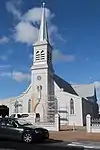 |
1879[20] | Heritage New Zealand Historic Place Category 2[21] |
| St Peter's Church | Wellington, Willis Street | 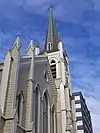 |
1879 | Heritage New Zealand Historic Place Category 1[22] |
| Wesley Church | Wellington, Taranaki Street |  Wesley Church at night |
1879 | Heritage New Zealand Historic Place Category 1[23] |
| Sacred Heart Church | Greytown |  Sacred Heart Church, Greytown |
1880 | To be deconsecrated in 2023.[24] A plaque on the wall of the church states that it is identical to St Joseph's catholic church at Tinui, which was later shifted to Riversdale. |
| St Mary's Church | Nelson | .jpg.webp) |
1882[25] | Heritage New Zealand Historic Place Category 2[26] |
| Bank of New Zealand Building No. 3 | Wellington, Customhouse Quay |  |
1883 | Heritage New Zealand Historic Place Category 1.[27] Built for National Mutual Life Association. Now forms part of the Old Bank Arcade. |
| Post & Telegraph building | Wellington, Customhouse Quay |  |
1884[28] | When it was built, this was the largest brick building in New Zealand, and it featured earthquake proofing. "The wood floors are so far independent of the main walls that the two materials may vibrate at different rates without any structural strain. The walls are also so constructed in sectional courses, and these courses are so bound and interlocked with bands of pliable wrought Iron, that a severe shake of the earth would fail to crack the hard shell with any serious result."[28] However the building had to be replaced when it was almost completely destroyed by fire in April 1887.[29] |
| St John's Church | Wellington, Willis Street | 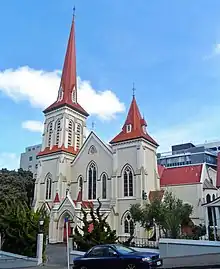 |
1885 | Heritage New Zealand Historic Place Category 1.[30] |
| Gear Meat Freezing Works | Petone | 1891 | Two storeyed building built for the freezing department of the works.[31] Demolished. | |
| former Woolworths building | Wellington, corner of Dixon & Cuba Streets |  |
1886 | Originally known as Te Aro House, and from 1928 as Burlington Arcade.[32][33] From 1951 until ca 1990 this was a Woolworths store. The façade has been retained and incorporated into the Te Auaha complex. |
| former City Meat Company building | Wellington, Stewart Dawson's Corner | 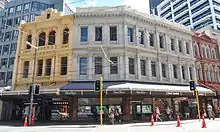 |
1896 | Heritage New Zealand Historic Place Category 2.[34] Façade retained and incorporated into new building. |
| Kirkcaldie & Stains | Wellington, Lambton Quay | 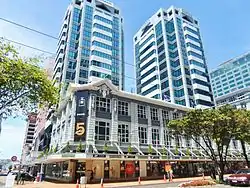 |
1897[35] | "Each of the three iron columns in the front of the premises weighs 3½ tons, and rests on blocks of bluestone obtained from Footscray, Victoria, that have a total weight of eight tons. The stone in the centre of the building weighs just four tons. The girder which is to be supported by the three columns is 64ft long, and weighs about 11 tons."[36] Opened in 1898.[37] Heritage New Zealand Historic Place Category 2.[38] The 1897 building was the middle section of the frontage, later altered. Façade retained and incorporated into new building. |
| Wellington Gas Company building | Wellington, Courtenay Place |  |
1898 | Heritage New Zealand Historic Place Category 2.[39][40] |
| Parliamentary Library | Wellington, Molesworth Street | 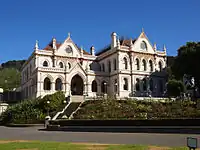 |
1899 | Heritage New Zealand Historic Place Category 1.[41] Turnbull's 3-storey design for the General Assembly Library (now known as the Parliamentary Library) was not completed because of rising costs, and it was finished with only two floors by John Campbell in 1899.[42] |
| Bank of New Zealand Building No. 1 | Wellington, Lambton Quay |  |
1899 | Heritage New Zealand Historic Place Category 1.[43] Now part of the Old Bank Arcade. |
| Bank of New Zealand Building no. 2 | Wellington, Lambton Quay | 1904 | Heritage New Zealand Historic Place Category 2.[44] Now part of the Old Bank Arcade. This building was designed by the firm of Thomas Turnbull and Son,[45] rather than Thomas Turnbull himself, who was probably retired by this time. |
References
- Cochran, Chris. "Thomas Turnbull". Dictionary of New Zealand Biography. Ministry for Culture and Heritage. Retrieved 1 December 2011.
- "Obituary: Mr Thomas Turnbull". New Zealand Times. 25 February 1907. Retrieved 18 March 2022 – via Paperspast.
- "San Francisco Chronicle at Newspapers.com". Newspapers.com. 17 October 1869. p. 1. Retrieved 18 March 2022.
- "Bank of New Zealand Building (No.1)". New Zealand Heritage List/Rārangi Kōrero. Heritage New Zealand. Retrieved 21 December 2009.
- "St John's Church". New Zealand Heritage List/Rārangi Kōrero. Heritage New Zealand. Retrieved 12 March 2016.
- Turnbull, Thomas (3 October 1888). "On earthquakes and architecture". Transactions and Proceedings of the Royal Society of New Zealand. 21: 498 – via Paperspast.
- "St Mary's Church, Wanganui". National Library of New Zealand. Retrieved 15 March 2022.
- "New buildings". Wanganui Chronicle. 8 March 1877. Retrieved 15 March 2022 – via Paperspast.
- Harding, William James. "St Mary's Church, Whanganui, around 1877". teara.govt.nz. Retrieved 15 March 2022.
- "[untitled]". Evening Post. 7 May 1878. Retrieved 15 March 2022 – via Paperspast.
- McGlone, Vincent J (1957). Fruits of toil : a history of the Catholic Church in the district of the Wairarapa, New Zealand, 1845-1956. Carterton, New Zealand: Roydhouse & Son. pp. 33, 119–124, 128 – via Paperspast.
- Fuller, Piers (25 November 2022). "110-year-old Carterton presbytery trucked south to become family home". Stuff. Retrieved 27 December 2022.
- "[untitled]". Levin Daily Chronicle. 2 February 1932. Retrieved 27 December 2022 – via Paperspast.
- "Blenheim". New Zealand Tablet. 12 November 1908. Retrieved 16 March 2022 – via Paperspast.
- "St Mary's Church (Catholic)". www.heritage.org.nz. Retrieved 19 March 2022.
- "Interior of the Te Aro Theatre, Wellington, New Zealand". Australasian Sketcher. 8 June 1878. Retrieved 26 December 2022 – via Trove.
- "Great fire in the city". Evening Post. 21 June 1879. Retrieved 27 December 2022 – via Paperspast.
- "Imperial Opera House". tiaki.natlib.govt.nz. Retrieved 26 December 2022.
- "[untitled]". New Zealand Times. 6 February 1878. Retrieved 16 March 2022 – via Paperspast.
- "Opening of St Patrick's Church at Masterton". Wairarapa Daily Times. 5 May 1879. Retrieved 16 March 2022 – via Paperspast.
- "St Patrick's Church (Catholic), including Cast-Iron Railing Fence and Gate". www.heritage.org.nz. Retrieved 19 March 2022.
- "St Peter's Church (Anglican)". www.heritage.org.nz. Retrieved 19 March 2022.
- "Wesley Church". www.heritage.org.nz. Retrieved 19 March 2022.
- Klein-Nixon, Kylie (25 December 2022). "A rare opportunity to turn historic Christmas Day church into a home". Stuff. Retrieved 26 December 2022.
- "The new St. Mary's Church, Nelson". New Zealand Tablet. 13 January 1882. Retrieved 16 March 2022 – via Paperspast.
- "St Mary's Church (Catholic)". www.heritage.org.nz. Retrieved 19 March 2022.
- "Bank of New Zealand Building (No 3)". www.heritage.org.nz. Retrieved 19 March 2022.
- "New Post and Telegraph offices". New Zealand Times. 19 January 1884. Retrieved 19 March 2022 – via Paperspast.
- "The fire". Evening Post. 28 April 1887. Retrieved 19 March 2022 – via Paperspast.
- "St John's Church (Presbyterian)". www.heritage.org.nz. Retrieved 19 March 2022.
- "Our frozen meat trade". Evening Post. 27 January 1891. Retrieved 17 March 2022 – via Paperspast.
- "Rebuilding of Te Aro House". New Zealand Mail. 15 January 1886. Retrieved 16 March 2022 – via Paperspast.
- "A metamorphosis". Evening Post. 7 September 1928. Retrieved 16 March 2022 – via Paperspast.
- "City Meat Company Building (Former)". www.heritage.org.nz. Retrieved 19 March 2022.
- "City improvements: Kirkcaldie & Stains's new premises". Evening Post. 3 July 1897. Retrieved 20 March 2022 – via Paperspast.
- "[untitled]". Evening Post. 11 November 1897. Retrieved 20 March 2022 – via Paperspast.
- "Kirkcaldie and Stains". New Zealand Mail. 7 July 1898. Retrieved 20 March 2022 – via Paperspast.
- "Kirkcaldie and Stains Department Store Facade". www.heritage.org.nz. Retrieved 19 March 2022.
- "Wellington Gas Company Building (Former)". www.heritage.org.nz. Retrieved 19 March 2022.
- "Wellington Gas Company Building (Former)". wellingtoncityheritage.org.nz. Retrieved 16 March 2022.
- "Parliamentary Library". www.heritage.org.nz. Retrieved 19 March 2022.
- "Parliamentary Library". Wellington City Council. 29 November 2017. Retrieved 16 June 2019.
- "Bank of New Zealand Building (No 1)". www.heritage.org.nz. Retrieved 19 March 2022.
- "Bank of New Zealand Building (No. 2)". www.heritage.org.nz. Retrieved 19 March 2022.
- "[untitled]". New Zealand Times. 4 May 1905. Retrieved 16 March 2022 – via Paperspast.